基于Sentinel1.8.8持久化流控规则和熔断降级规则到Nacos2.3.0
- 0.概述
- 1.准备工作
- 2.源码改造开始
- 2.1修改 pom.xml 文件
- 2.2复制官方对Nacos支持的源码
- 2.3 修改application.properties 文件,添加 Nacos 服务器的相关配置
- 2.4 新建Nacos配置文件的读取类NacosPropertiesConfiguration.java
- 2.5 修改 NacosConfig 类以支持自定义配置:
- 2.6 修改 NacosConfigUtil类以支持熔断规则及其他规则:
- 2.7 修改 FlowRuleNacosPublisher 确认配置文件格式为美化的JSON
- 2.8 新增DegradeRuleNacosProvider和DegradeRuleNacosPublisher
- 2.9 修改FlowControllerV1源码
- 2.10 修改DegradeController源码
- 2.11 改造规则ID
- 3 项目使用
- 4 完成
0.概述
Sentinel 控制台是流量控制、熔断降级规则统一配置和管理的入口,它为用户提供了机器自发现、簇点链路自发现、监控、规则配置等功能。在 Sentinel 控制台上,我们可以配置规则并实时查看流量控制效果。
Sentinel客户端默认情况下接收到 Dashboard 推送的规则配置后,可以实时生效。但是,有一个致命缺陷,Dashboard和业务服务并没有持久化这些配置,当业务服务重启后,由于规则默认是存储在内存中的,这些规则配置将全部丢失。
那么,本文将介绍如何改造Sentinel-dashboard源码,实现将规则持久化到 Nacos配置中心
Sentinel 的理念是开发者只需要关注资源的定义,当资源定义成功后可以动态增加各种流控降级规则:
Sentinel 提供两种方式修改规则:
- 通过 API 直接修改 (
loadRules) - 通过
DataSource适配不同数据源修改
通过 API 修改比较直观,可以通过以下几个 API 修改不同的规则:
FlowRuleManager.loadRules(List<FlowRule> rules); // 修改流控规则
DegradeRuleManager.loadRules(List<DegradeRule> rules); // 修改降级规则
手动修改规则(硬编码方式)一般仅用于测试和演示,生产上一般通过动态规则源的方式来动态管理规则。
上述 loadRules() 方法只接受内存态的规则对象,但更多时候规则存储在文件、数据库或者配置中心当中。DataSource 接口给我们提供了对接任意配置源的能力。相比直接通过 API 修改规则,实现 DataSource 接口是更加可靠的做法。
下面引用官方的资料进一步介绍一下:官方wiki
一般来说,规则的推送有下面三种模式:
| 推送模式 | 说明 | 优点 | 缺点 |
|---|---|---|---|
| 原始模式 | API 将规则推送至客户端并直接更新到内存中,扩展写数据源(WritableDataSource) | 简单,无任何依赖 | 不保证一致性;规则保存在内存中,重启即消失。严重不建议用于生产环境 |
| Pull 模式 | 扩展写数据源(WritableDataSource), 客户端主动向某个规则管理中心定期轮询拉取规则,这个规则中心可以是 RDBMS、文件 等 | 简单,无任何依赖;规则持久化 | 不保证一致性;实时性不保证,拉取过于频繁也可能会有性能问题。 |
| Push 模式 | 扩展读数据源(ReadableDataSource),规则中心统一推送,客户端通过注册监听器的方式时刻监听变化,比如使用 Nacos、Zookeeper 等配置中心。这种方式有更好的实时性和一致性保证。生产环境下一般采用 push 模式的数据源。 | 规则持久化;一致性;快速 | 引入第三方依赖 |
原始模式
如果不做任何修改,Dashboard 的推送规则方式是通过 API 将规则推送至客户端并直接更新到内存中:
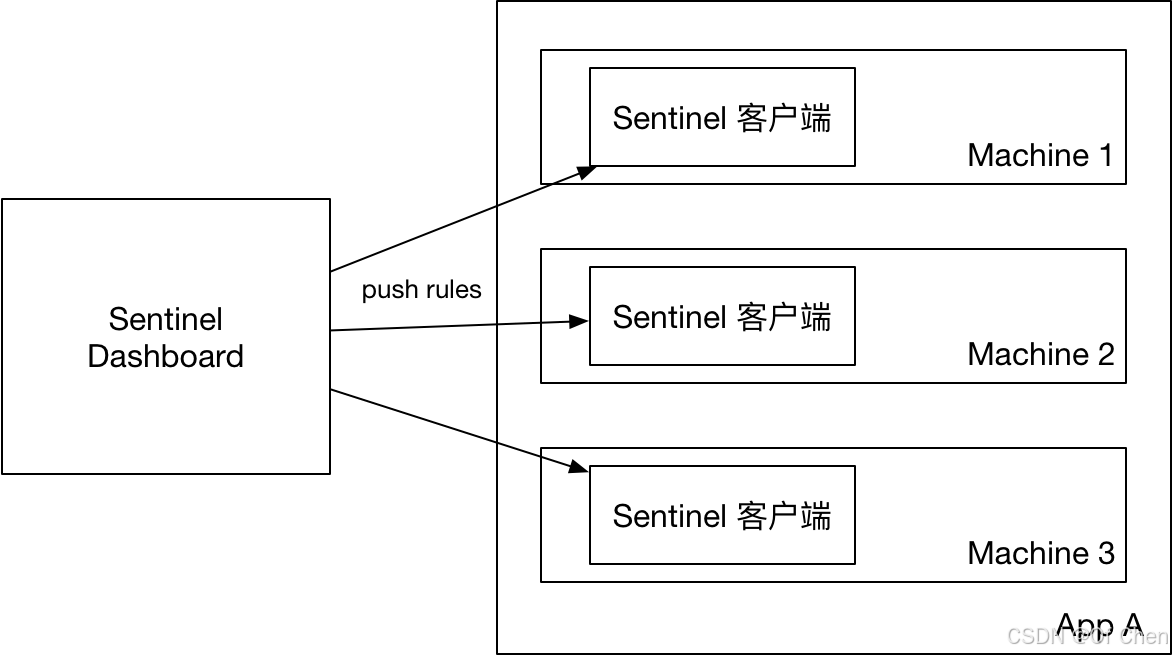
这种做法的好处是简单,无依赖;坏处是应用重启规则就会消失,仅用于简单测试,不能用于生产环境。
Pull模式
pull 模式的数据源(如本地文件、RDBMS 等)一般是可写入的。使用时需要在客户端注册数据源:将对应的读数据源注册至对应的 RuleManager,将写数据源注册至 transport 的 WritableDataSourceRegistry 中。以本地文件数据源为例:
public class FileDataSourceInit implements InitFunc {
@Override
public void init() throws Exception {
String flowRulePath = "xxx";
ReadableDataSource<String, List<FlowRule>> ds = new FileRefreshableDataSource<>(
flowRulePath, source -> JSON.parseObject(source, new TypeReference<List<FlowRule>>() {})
);
// 将可读数据源注册至 FlowRuleManager.
FlowRuleManager.register2Property(ds.getProperty());
WritableDataSource<List<FlowRule>> wds = new FileWritableDataSource<>(flowRulePath, this::encodeJson);
// 将可写数据源注册至 transport 模块的 WritableDataSourceRegistry 中.
// 这样收到控制台推送的规则时,Sentinel 会先更新到内存,然后将规则写入到文件中.
WritableDataSourceRegistry.registerFlowDataSource(wds);
}
private <T> String encodeJson(T t) {
return JSON.toJSONString(t);
}
}
本地文件数据源会定时轮询文件的变更,读取规则。这样我们既可以在应用本地直接修改文件来更新规则,也可以通过 Sentinel 控制台推送规则。以本地文件数据源为例,推送过程如下图所示:

首先 Sentinel 控制台通过 API 将规则推送至客户端并更新到内存中,接着注册的写数据源会将新的规则保存到本地的文件中。使用 pull 模式的数据源时一般不需要对 Sentinel 控制台进行改造。
这种实现方法好处是简单,不引入新的依赖,坏处是无法保证监控数据的一致性。
Push模式
生产环境下一般更常用的是 push 模式的数据源。对于 push 模式的数据源,如远程配置中心(ZooKeeper, Nacos, Apollo等等),推送的操作不应由 Sentinel 客户端进行,而应该经控制台统一进行管理,直接进行推送,数据源仅负责获取配置中心推送的配置并更新到本地。因此推送规则正确做法应该是 配置中心控制台/Sentinel 控制台 → 配置中心 → Sentinel 数据源 → Sentinel,而不是经 Sentinel 数据源推送至配置中心。这样的流程就非常清晰了:

本文将基于Push模式对sentinel-dashboard进行改造,使其规则持久化到Nacos中
1.准备工作
在开始之前,请确保已安装以下软件:(这里安装不再赘述)
- 本地基础环境:
- Java 8 或更高版本
- Maven 或其他构建工具
- 安装部署Nacos 服务端(版本2.x以上均可,我这里用自己改造的2.24),详解《Nacos2.24持久化到Postgres数据库适配》
- 主角
- Sentinel 控制台(版本推荐 1.8.8),拉取官方源码:地址
拉取完在IDEA中是这样的:
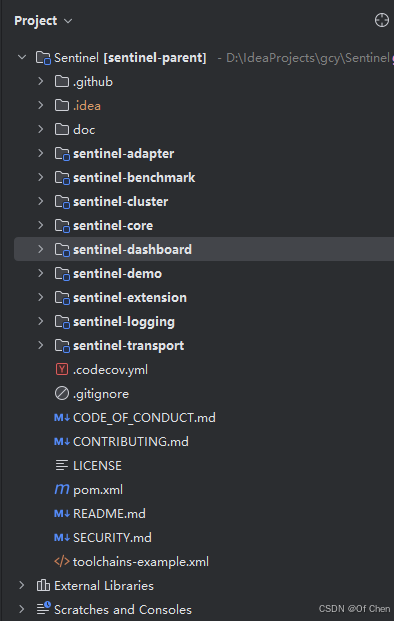
我们的主角是:
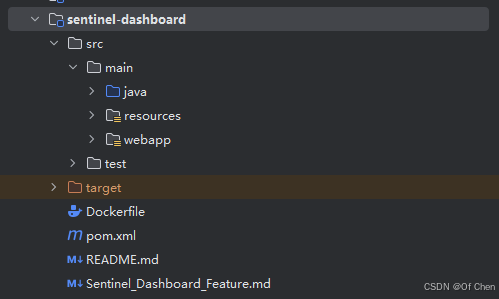
2.源码改造开始
2.1修改 pom.xml 文件
在sentinel-dashboard/pom.xml中,默认的 scope 是 test,表示只能在测试时使用,这里要注释或删掉如下<scope>test</scope> ;这里我加入了gson依赖,后面会有用
<!-- for Nacos rule publisher sample -->
<dependency>
<groupId>com.alibaba.csp</groupId>
<artifactId>sentinel-datasource-nacos</artifactId>
<!-- <scope>test</scope> -->
</dependency>
<!-- 美化JSON -->
<dependency>
<groupId>com.google.code.gson</groupId>
<artifactId>gson</artifactId>
<version>2.8.9</version>
</dependency>
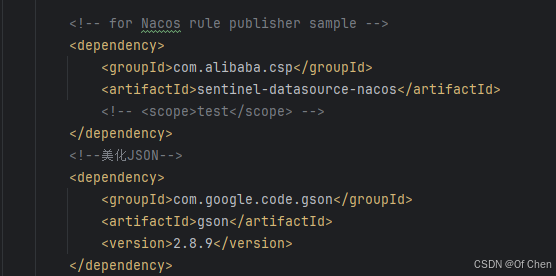
2.2复制官方对Nacos支持的源码
在sentinel-dashboard/src/test/java/com/alibaba/csp/sentinel/dashboard/rule/nacos中将nacos整个包复制到sentinel-dashboard/src/main/java/com/alibaba/csp/sentinel/dashboard/rule/包下,包中有四个类:FlowRuleNacosProvider、FlowRuleNacosPublisher、NacosConfig 和 NacosConfigUtils
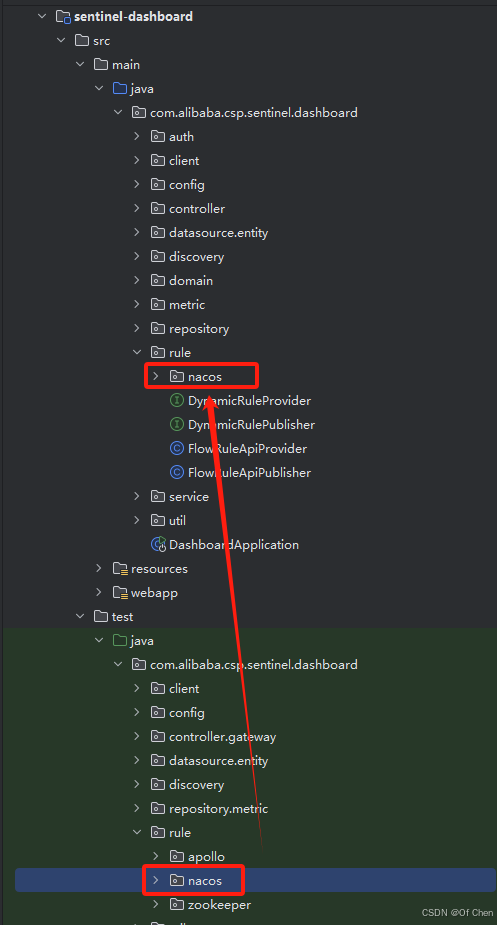
这里需要注意一下,复制过去了,就把test下的nacos整个包删除,避免又调用到了这里,虽然我们pom.xml中删除或注释掉了test,但是还是避免一下,否则你修改源码的时候点击方法跳转的时候可能会跳到test包中,导致改错地方了
2.3 修改application.properties 文件,添加 Nacos 服务器的相关配置
# 新加Sentinel连接nacos配置
sentinel.nacos.serverAddr=你的nacos地址
sentinel.nacos.username=nacos用户名
sentinel.nacos.password=nacos密码
sentinel.nacos.namespace=nacos命名空间
sentinel.nacos.groupId=SENTINEL_GROUP
2.4 新建Nacos配置文件的读取类NacosPropertiesConfiguration.java
在sentinel-dashboard/src/main/java/com/alibaba/csp/sentinel/dashboard/rule/nacos/目录下新建NacosPropertiesConfiguration.java类:
@ConfigurationProperties(prefix = "sentinel.nacos")
@Configuration
public class NacosPropertiesConfiguration {
private String serverAddr;
private String namespace;
private String groupId;
private String username;
private String password;
// 省略setter/getter
}
2.5 修改 NacosConfig 类以支持自定义配置:
import com.alibaba.csp.sentinel.dashboard.datasource.entity.rule.DegradeRuleEntity;
import com.alibaba.csp.sentinel.dashboard.datasource.entity.rule.FlowRuleEntity;
import com.alibaba.csp.sentinel.datasource.Converter;
import com.alibaba.fastjson.JSON;
import com.alibaba.nacos.api.PropertyKeyConst;
import com.alibaba.nacos.api.config.ConfigFactory;
import com.alibaba.nacos.api.config.ConfigService;
import org.springframework.context.annotation.Bean;
import org.springframework.context.annotation.Configuration;
import java.util.List;
import java.util.Properties;
@Configuration
public class NacosConfig {
@Bean
public Converter<List<FlowRuleEntity>, String> flowRuleEntityEncoder() {
return JSON::toJSONString;
}
@Bean
public Converter<String, List<FlowRuleEntity>> flowRuleEntityDecoder() {
return s -> JSON.parseArray(s, FlowRuleEntity.class);
}
@Bean
public Converter<List<DegradeRuleEntity>, String> degradeRuleEntityEncoder() {
return JSON::toJSONString;
}
@Bean
public Converter<String, List<DegradeRuleEntity>> degradeRuleEntityDecoder() {
return s -> JSON.parseArray(s, DegradeRuleEntity.class);
}
@Bean
public ConfigService nacosConfigService(NacosPropertiesConfiguration nacosPropertiesConfiguration) throws Exception {
Properties properties = new Properties();
properties.put(PropertyKeyConst.SERVER_ADDR, nacosPropertiesConfiguration.getServerAddr());
properties.put(PropertyKeyConst.NAMESPACE, nacosPropertiesConfiguration.getNamespace());
properties.put("groupId", nacosPropertiesConfiguration.getGroupId());
properties.put(PropertyKeyConst.USERNAME, nacosPropertiesConfiguration.getUsername());
properties.put(PropertyKeyConst.PASSWORD, nacosPropertiesConfiguration.getPassword());
return ConfigFactory.createConfigService(properties);
// return ConfigFactory.createConfigService("localhost"); // 原代码
}
}
2.6 修改 NacosConfigUtil类以支持熔断规则及其他规则:
public final class NacosConfigUtil {
public static final String GROUP_ID = "SENTINEL_GROUP";
public static final String FLOW_DATA_ID_POSTFIX = "-flow-rules";
/**
* 增加对熔断规则的支持
*/
public static final String DEGRADE_DATA_ID_POSTFIX = "-degrade-rules";
public static final String PARAM_FLOW_DATA_ID_POSTFIX = "-param-rules";
public static final String CLUSTER_MAP_DATA_ID_POSTFIX = "-cluster-map";
/**
* cc for `cluster-client`
*/
public static final String CLIENT_CONFIG_DATA_ID_POSTFIX = "-cc-config";
/**
* cs for `cluster-server`
*/
public static final String SERVER_TRANSPORT_CONFIG_DATA_ID_POSTFIX = "-cs-transport-config";
public static final String SERVER_FLOW_CONFIG_DATA_ID_POSTFIX = "-cs-flow-config";
public static final String SERVER_NAMESPACE_SET_DATA_ID_POSTFIX = "-cs-namespace-set";
private NacosConfigUtil() {}
}
2.7 修改 FlowRuleNacosPublisher 确认配置文件格式为美化的JSON
import com.alibaba.csp.sentinel.dashboard.datasource.entity.rule.FlowRuleEntity;
import com.alibaba.csp.sentinel.dashboard.rule.DynamicRulePublisher;
import com.alibaba.csp.sentinel.datasource.Converter;
import com.alibaba.csp.sentinel.util.AssertUtil;
import com.alibaba.fastjson.JSONArray;
import com.alibaba.nacos.api.config.ConfigService;
import com.alibaba.nacos.api.config.ConfigType;
import com.google.gson.Gson;
import com.google.gson.GsonBuilder;
import com.google.gson.JsonArray;
import com.google.gson.JsonParser;
import org.slf4j.Logger;
import org.slf4j.LoggerFactory;
import org.springframework.beans.factory.annotation.Autowired;
import org.springframework.stereotype.Component;
import java.util.List;
@Component("flowRuleNacosPublisher")
public class FlowRuleNacosPublisher implements DynamicRulePublisher<List<FlowRuleEntity>> {
private final Logger log = LoggerFactory.getLogger(FlowRuleNacosPublisher.class);
@Autowired
private ConfigService configService;
@Autowired
private Converter<List<FlowRuleEntity>, String> converter;
@Override
public void publish(String app, List<FlowRuleEntity> rules) throws Exception {
AssertUtil.notEmpty(app, "app name cannot be empty");
if (rules == null) {
return;
}
// 美化xxx-flow-rules.yml配置中的格式
String prettyFormat = toPrettyFormat(JSONArray.toJSONString(rules));
log.info("flow rules change and publish, app=" + app + ", rules=" + prettyFormat);
configService.publishConfig(app + NacosConfigUtil.FLOW_DATA_ID_POSTFIX,
NacosConfigUtil.GROUP_ID, prettyFormat, ConfigType.JSON.getType());
}
/**
* 格式化输出JSON字符串
*
* @return 格式化后的JSON字符串
*/
private String toPrettyFormat(String json) {
JsonArray asJsonArray = JsonParser.parseString(json).getAsJsonArray();
Gson gson = new GsonBuilder().setPrettyPrinting().create();
return gson.toJson(asJsonArray);
}
}
这里要插一嘴,为什么前面要引入gson的依赖,就是这里要做一下美化json格式,如果没有美化,那么后面在sentinel-dashboard页面持久化到nacos中的时候,就是这个鬼样子:
美化之前
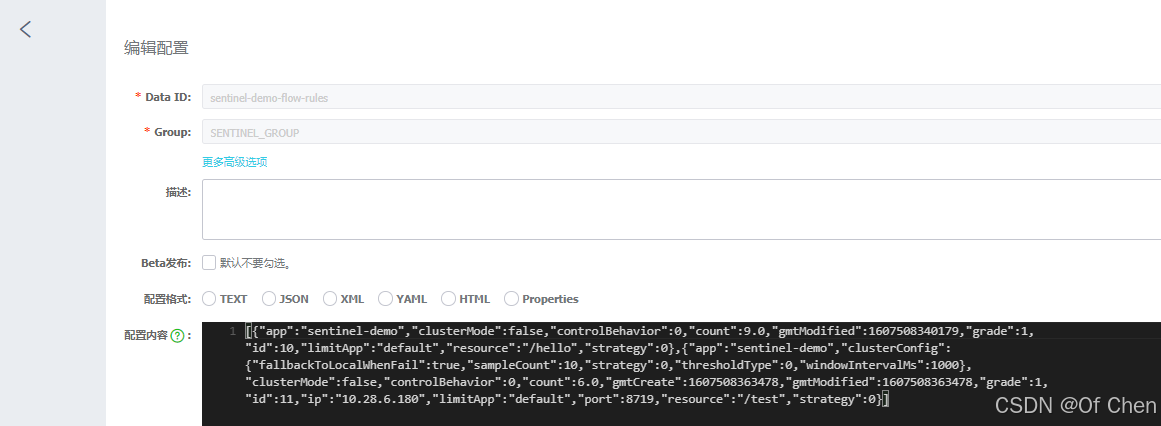
美化之后
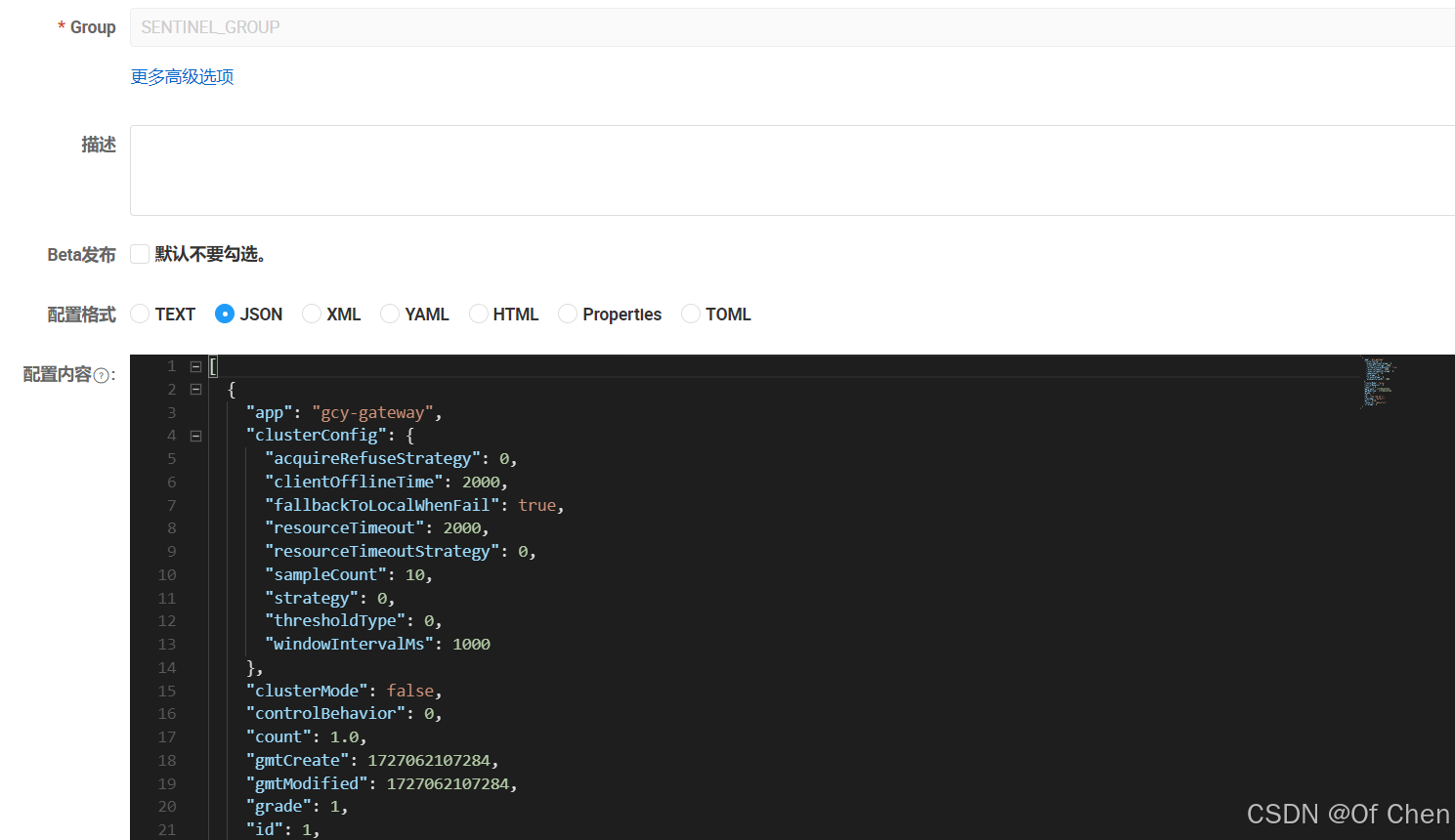
2.8 新增DegradeRuleNacosProvider和DegradeRuleNacosPublisher
同样的,在nacos包下,可以新建,也可以从FlowRuleNacosProvider和FlowRuleNacosPublisher复制过来修改,代码如下:
DegradeRuleNacosProvider类
import com.alibaba.csp.sentinel.dashboard.datasource.entity.rule.DegradeRuleEntity;
import com.alibaba.csp.sentinel.dashboard.rule.DynamicRuleProvider;
import com.alibaba.csp.sentinel.datasource.Converter;
import com.alibaba.csp.sentinel.util.StringUtil;
import com.alibaba.nacos.api.config.ConfigService;
import org.springframework.beans.factory.annotation.Autowired;
import org.springframework.stereotype.Component;
import java.util.ArrayList;
import java.util.List;
@Component("degradeRuleNacosProvider")
public class DegradeRuleNacosProvider implements DynamicRuleProvider<List<DegradeRuleEntity>> {
@Autowired
private ConfigService configService;
@Autowired
private Converter<String, List<DegradeRuleEntity>> converter;
@Override
public List<DegradeRuleEntity> getRules(String appName) throws Exception {
String rules = configService.getConfig(appName + NacosConfigUtil.DEGRADE_DATA_ID_POSTFIX,
NacosConfigUtil.GROUP_ID, 3000);
if (StringUtil.isEmpty(rules)) {
return new ArrayList<>();
}
return converter.convert(rules);
}
}
DegradeRuleNacosPublisher类
import com.alibaba.csp.sentinel.dashboard.datasource.entity.rule.DegradeRuleEntity;
import com.alibaba.csp.sentinel.dashboard.rule.DynamicRulePublisher;
import com.alibaba.csp.sentinel.datasource.Converter;
import com.alibaba.csp.sentinel.util.AssertUtil;
import com.alibaba.fastjson.JSONArray;
import com.alibaba.nacos.api.config.ConfigService;
import com.alibaba.nacos.api.config.ConfigType;
import com.google.gson.Gson;
import com.google.gson.GsonBuilder;
import com.google.gson.JsonArray;
import com.google.gson.JsonParser;
import org.slf4j.Logger;
import org.slf4j.LoggerFactory;
import org.springframework.beans.factory.annotation.Autowired;
import org.springframework.stereotype.Component;
import java.util.List;
@Component("degradeRuleNacosPublisher")
public class DegradeRuleNacosPublisher implements DynamicRulePublisher<List<DegradeRuleEntity>> {
private final Logger log = LoggerFactory.getLogger(DegradeRuleNacosPublisher.class);
@Autowired
private ConfigService configService;
@Autowired
private Converter<List<DegradeRuleEntity>, String> converter;
@Override
public void publish(String app, List<DegradeRuleEntity> rules) throws Exception {
AssertUtil.notEmpty(app, "app name cannot be empty");
if (rules == null) {
return;
}
// 美化xxxx-degrade-rules.yml配置中的格式
String prettyFormat = toPrettyFormat(JSONArray.toJSONString(rules));
log.info("degrade rules change and publish, app=" + app + ", rules=" + prettyFormat);
configService.publishConfig(app + NacosConfigUtil.DEGRADE_DATA_ID_POSTFIX,
NacosConfigUtil.GROUP_ID, prettyFormat, ConfigType.JSON.getType());
}
/**
* 格式化输出JSON字符串
*
* @return 格式化后的JSON字符串
*/
private String toPrettyFormat(String json) {
JsonArray asJsonArray = JsonParser.parseString(json).getAsJsonArray();
Gson gson = new GsonBuilder().setPrettyPrinting().create();
return gson.toJson(asJsonArray);
}
}
最终nacos包下的类如下:
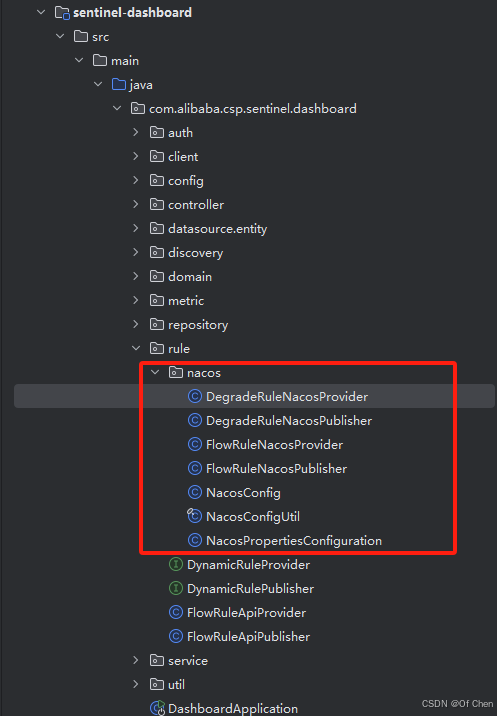
其他热点规则,系统规则,授权规则……如法炮制,这里不赘述了
2.9 修改FlowControllerV1源码
在sentinel-dashboard/src/main/java/com/alibaba/csp/sentinel/dashboard/controller/FlowControllerV1.java进行改造
直接上改造后的源码:
import java.util.Date;
import java.util.List;
import java.util.concurrent.CompletableFuture;
import java.util.concurrent.ExecutionException;
import java.util.concurrent.TimeUnit;
import com.alibaba.csp.sentinel.dashboard.auth.AuthAction;
import com.alibaba.csp.sentinel.dashboard.auth.AuthService.PrivilegeType;
import com.alibaba.csp.sentinel.dashboard.discovery.AppManagement;
import com.alibaba.csp.sentinel.dashboard.rule.DynamicRuleProvider;
import com.alibaba.csp.sentinel.dashboard.rule.DynamicRulePublisher;
import com.alibaba.csp.sentinel.util.StringUtil;
import com.alibaba.csp.sentinel.dashboard.client.SentinelApiClient;
import com.alibaba.csp.sentinel.dashboard.datasource.entity.rule.FlowRuleEntity;
import com.alibaba.csp.sentinel.dashboard.discovery.MachineInfo;
import com.alibaba.csp.sentinel.dashboard.domain.Result;
import com.alibaba.csp.sentinel.dashboard.repository.rule.InMemoryRuleRepositoryAdapter;
import org.slf4j.Logger;
import org.slf4j.LoggerFactory;
import org.springframework.beans.factory.annotation.Autowired;
import org.springframework.beans.factory.annotation.Qualifier;
import org.springframework.util.CollectionUtils;
import org.springframework.web.bind.annotation.DeleteMapping;
import org.springframework.web.bind.annotation.GetMapping;
import org.springframework.web.bind.annotation.PostMapping;
import org.springframework.web.bind.annotation.PutMapping;
import org.springframework.web.bind.annotation.RequestBody;
import org.springframework.web.bind.annotation.RequestMapping;
import org.springframework.web.bind.annotation.RequestParam;
import org.springframework.web.bind.annotation.RestController;
/**
* Flow rule controller.
*
* @author leyou
* @author Eric Zhao
*/
@RestController
@RequestMapping(value = "/v1/flow")
public class FlowControllerV1 {
private final Logger logger = LoggerFactory.getLogger(FlowControllerV1.class);
@Autowired
private InMemoryRuleRepositoryAdapter<FlowRuleEntity> repository;
@Autowired
private AppManagement appManagement;
@Autowired
private SentinelApiClient sentinelApiClient;
@Autowired
@Qualifier("flowRuleNacosProvider")
private DynamicRuleProvider<List<FlowRuleEntity>> ruleProvider;
@Autowired
@Qualifier("flowRuleNacosPublisher")
private DynamicRulePublisher<List<FlowRuleEntity>> rulePublisher;
@GetMapping("/rules")
@AuthAction(PrivilegeType.READ_RULE)
public Result<List<FlowRuleEntity>> apiQueryMachineRules(@RequestParam String app,
@RequestParam String ip,
@RequestParam Integer port) {
if (StringUtil.isEmpty(app)) {
return Result.ofFail(-1, "app can't be null or empty");
}
if (StringUtil.isEmpty(ip)) {
return Result.ofFail(-1, "ip can't be null or empty");
}
if (port == null) {
return Result.ofFail(-1, "port can't be null");
}
if (!appManagement.isValidMachineOfApp(app, ip)) {
return Result.ofFail(-1, "given ip does not belong to given app");
}
try {
// List<FlowRuleEntity> rules = sentinelApiClient.fetchFlowRuleOfMachine(app, ip, port);
List<FlowRuleEntity> rules = ruleProvider.getRules(app);
if (rules != null && !rules.isEmpty()) {
for (FlowRuleEntity entity : rules) {
entity.setApp(app);
if (entity.getClusterConfig() != null && entity.getClusterConfig().getFlowId() != null) {
entity.setId(entity.getClusterConfig().getFlowId());
}
}
}
rules = repository.saveAll(rules);
return Result.ofSuccess(rules);
} catch (Throwable throwable) {
logger.error("Error when querying flow rules", throwable);
return Result.ofThrowable(-1, throwable);
}
}
private <R> Result<R> checkEntityInternal(FlowRuleEntity entity) {
if (StringUtil.isBlank(entity.getApp())) {
return Result.ofFail(-1, "app can't be null or empty");
}
if (StringUtil.isBlank(entity.getIp())) {
return Result.ofFail(-1, "ip can't be null or empty");
}
if (entity.getPort() == null) {
return Result.ofFail(-1, "port can't be null");
}
if (!appManagement.isValidMachineOfApp(entity.getApp(), entity.getIp())) {
return Result.ofFail(-1, "given ip does not belong to given app");
}
if (StringUtil.isBlank(entity.getLimitApp())) {
return Result.ofFail(-1, "limitApp can't be null or empty");
}
if (StringUtil.isBlank(entity.getResource())) {
return Result.ofFail(-1, "resource can't be null or empty");
}
if (entity.getGrade() == null) {
return Result.ofFail(-1, "grade can't be null");
}
if (entity.getGrade() != 0 && entity.getGrade() != 1) {
return Result.ofFail(-1, "grade must be 0 or 1, but " + entity.getGrade() + " got");
}
if (entity.getCount() == null || entity.getCount() < 0) {
return Result.ofFail(-1, "count should be at lease zero");
}
if (entity.getStrategy() == null) {
return Result.ofFail(-1, "strategy can't be null");
}
if (entity.getStrategy() != 0 && StringUtil.isBlank(entity.getRefResource())) {
return Result.ofFail(-1, "refResource can't be null or empty when strategy!=0");
}
if (entity.getControlBehavior() == null) {
return Result.ofFail(-1, "controlBehavior can't be null");
}
int controlBehavior = entity.getControlBehavior();
if (controlBehavior == 1 && entity.getWarmUpPeriodSec() == null) {
return Result.ofFail(-1, "warmUpPeriodSec can't be null when controlBehavior==1");
}
if (controlBehavior == 2 && entity.getMaxQueueingTimeMs() == null) {
return Result.ofFail(-1, "maxQueueingTimeMs can't be null when controlBehavior==2");
}
if (entity.isClusterMode() && entity.getClusterConfig() == null) {
return Result.ofFail(-1, "cluster config should be valid");
}
return null;
}
@PostMapping("/rule")
@AuthAction(PrivilegeType.WRITE_RULE)
public Result<FlowRuleEntity> apiAddFlowRule(@RequestBody FlowRuleEntity entity) {
Result<FlowRuleEntity> checkResult = checkEntityInternal(entity);
if (checkResult != null) {
return checkResult;
}
entity.setId(null);
Date date = new Date();
entity.setGmtCreate(date);
entity.setGmtModified(date);
entity.setLimitApp(entity.getLimitApp().trim());
entity.setResource(entity.getResource().trim());
try {
entity = repository.save(entity);
publishRules(entity.getApp(), entity.getIp(), entity.getPort()).get(5000, TimeUnit.MILLISECONDS);
return Result.ofSuccess(entity);
} catch (Throwable t) {
Throwable e = t instanceof ExecutionException ? t.getCause() : t;
logger.error("Failed to add new flow rule, app={}, ip={}", entity.getApp(), entity.getIp(), e);
return Result.ofFail(-1, e.getMessage());
}
}
@PutMapping("/save.json")
@AuthAction(PrivilegeType.WRITE_RULE)
public Result<FlowRuleEntity> apiUpdateFlowRule(Long id, String app,
String limitApp, String resource, Integer grade,
Double count, Integer strategy, String refResource,
Integer controlBehavior, Integer warmUpPeriodSec,
Integer maxQueueingTimeMs) {
if (id == null) {
return Result.ofFail(-1, "id can't be null");
}
FlowRuleEntity entity = repository.findById(id);
if (entity == null) {
return Result.ofFail(-1, "id " + id + " dose not exist");
}
if (StringUtil.isNotBlank(app)) {
entity.setApp(app.trim());
}
if (StringUtil.isNotBlank(limitApp)) {
entity.setLimitApp(limitApp.trim());
}
if (StringUtil.isNotBlank(resource)) {
entity.setResource(resource.trim());
}
if (grade != null) {
if (grade != 0 && grade != 1) {
return Result.ofFail(-1, "grade must be 0 or 1, but " + grade + " got");
}
entity.setGrade(grade);
}
if (count != null) {
entity.setCount(count);
}
if (strategy != null) {
if (strategy != 0 && strategy != 1 && strategy != 2) {
return Result.ofFail(-1, "strategy must be in [0, 1, 2], but " + strategy + " got");
}
entity.setStrategy(strategy);
if (strategy != 0) {
if (StringUtil.isBlank(refResource)) {
return Result.ofFail(-1, "refResource can't be null or empty when strategy!=0");
}
entity.setRefResource(refResource.trim());
}
}
if (controlBehavior != null) {
if (controlBehavior != 0 && controlBehavior != 1 && controlBehavior != 2) {
return Result.ofFail(-1, "controlBehavior must be in [0, 1, 2], but " + controlBehavior + " got");
}
if (controlBehavior == 1 && warmUpPeriodSec == null) {
return Result.ofFail(-1, "warmUpPeriodSec can't be null when controlBehavior==1");
}
if (controlBehavior == 2 && maxQueueingTimeMs == null) {
return Result.ofFail(-1, "maxQueueingTimeMs can't be null when controlBehavior==2");
}
entity.setControlBehavior(controlBehavior);
if (warmUpPeriodSec != null) {
entity.setWarmUpPeriodSec(warmUpPeriodSec);
}
if (maxQueueingTimeMs != null) {
entity.setMaxQueueingTimeMs(maxQueueingTimeMs);
}
}
Date date = new Date();
entity.setGmtModified(date);
try {
entity = repository.save(entity);
if (entity == null) {
return Result.ofFail(-1, "save entity fail: null");
}
publishRules(entity.getApp(), entity.getIp(), entity.getPort()).get(5000, TimeUnit.MILLISECONDS);
return Result.ofSuccess(entity);
} catch (Throwable t) {
Throwable e = t instanceof ExecutionException ? t.getCause() : t;
logger.error("Error when updating flow rules, app={}, ip={}, ruleId={}", entity.getApp(),
entity.getIp(), id, e);
return Result.ofFail(-1, e.getMessage());
}
}
@DeleteMapping("/delete.json")
@AuthAction(PrivilegeType.WRITE_RULE)
public Result<Long> apiDeleteFlowRule(Long id) {
if (id == null) {
return Result.ofFail(-1, "id can't be null");
}
FlowRuleEntity oldEntity = repository.findById(id);
if (oldEntity == null) {
return Result.ofSuccess(null);
}
try {
repository.delete(id);
} catch (Exception e) {
return Result.ofFail(-1, e.getMessage());
}
try {
publishRules(oldEntity.getApp(), oldEntity.getIp(), oldEntity.getPort()).get(5000, TimeUnit.MILLISECONDS);
return Result.ofSuccess(id);
} catch (Throwable t) {
Throwable e = t instanceof ExecutionException ? t.getCause() : t;
logger.error("Error when deleting flow rules, app={}, ip={}, id={}", oldEntity.getApp(),
oldEntity.getIp(), id, e);
return Result.ofFail(-1, e.getMessage());
}
}
private CompletableFuture<Void> publishRules(String app, String ip, Integer port) throws Exception {
List<FlowRuleEntity> rules = repository.findAllByMachine(MachineInfo.of(app, ip, port));
// 将数据推送到Nacos配置中心
rulePublisher.publish(app, rules);
return sentinelApiClient.setFlowRuleOfMachineAsync(app, ip, port, rules);
}
}
2.10 修改DegradeController源码
在sentinel-dashboard/src/main/java/com/alibaba/csp/sentinel/dashboard/controller/DegradeController.java中改造
直接上改造后的源码:
import com.alibaba.csp.sentinel.dashboard.auth.AuthAction;
import com.alibaba.csp.sentinel.dashboard.auth.AuthService.PrivilegeType;
import com.alibaba.csp.sentinel.dashboard.client.SentinelApiClient;
import com.alibaba.csp.sentinel.dashboard.datasource.entity.rule.DegradeRuleEntity;
import com.alibaba.csp.sentinel.dashboard.discovery.AppManagement;
import com.alibaba.csp.sentinel.dashboard.discovery.MachineInfo;
import com.alibaba.csp.sentinel.dashboard.domain.Result;
import com.alibaba.csp.sentinel.dashboard.repository.rule.RuleRepository;
import com.alibaba.csp.sentinel.dashboard.rule.DynamicRuleProvider;
import com.alibaba.csp.sentinel.dashboard.rule.DynamicRulePublisher;
import com.alibaba.csp.sentinel.slots.block.RuleConstant;
import com.alibaba.csp.sentinel.slots.block.degrade.circuitbreaker.CircuitBreakerStrategy;
import com.alibaba.csp.sentinel.util.StringUtil;
import org.slf4j.Logger;
import org.slf4j.LoggerFactory;
import org.springframework.beans.factory.annotation.Autowired;
import org.springframework.beans.factory.annotation.Qualifier;
import org.springframework.web.bind.annotation.*;
import java.util.Date;
import java.util.List;
/**
* Controller regarding APIs of degrade rules. Refactored since 1.8.0.
*
* @author Carpenter Lee
* @author Eric Zhao
*/
@RestController
@RequestMapping("/degrade")
public class DegradeController {
private final Logger logger = LoggerFactory.getLogger(DegradeController.class);
@Autowired
private RuleRepository<DegradeRuleEntity, Long> repository;
@Autowired
private SentinelApiClient sentinelApiClient;
@Autowired
private AppManagement appManagement;
@Autowired
@Qualifier("degradeRuleNacosProvider")
private DynamicRuleProvider<List<DegradeRuleEntity>> ruleProvider;
@Autowired
@Qualifier("degradeRuleNacosPublisher")
private DynamicRulePublisher<List<DegradeRuleEntity>> rulePublisher;
@GetMapping("/rules.json")
@AuthAction(PrivilegeType.READ_RULE)
public Result<List<DegradeRuleEntity>> apiQueryMachineRules(String app, String ip, Integer port) {
if (StringUtil.isEmpty(app)) {
return Result.ofFail(-1, "app can't be null or empty");
}
if (StringUtil.isEmpty(ip)) {
return Result.ofFail(-1, "ip can't be null or empty");
}
if (port == null) {
return Result.ofFail(-1, "port can't be null");
}
if (!appManagement.isValidMachineOfApp(app, ip)) {
return Result.ofFail(-1, "given ip does not belong to given app");
}
try {
// List<DegradeRuleEntity> rules = sentinelApiClient.fetchDegradeRuleOfMachine(app, ip, port);
List<DegradeRuleEntity> rules = ruleProvider.getRules(app);
rules = repository.saveAll(rules);
return Result.ofSuccess(rules);
} catch (Throwable throwable) {
logger.error("queryApps error:", throwable);
return Result.ofThrowable(-1, throwable);
}
}
@PostMapping("/rule")
@AuthAction(PrivilegeType.WRITE_RULE)
public Result<DegradeRuleEntity> apiAddRule(@RequestBody DegradeRuleEntity entity) {
Result<DegradeRuleEntity> checkResult = checkEntityInternal(entity);
if (checkResult != null) {
return checkResult;
}
Date date = new Date();
entity.setGmtCreate(date);
entity.setGmtModified(date);
try {
entity = repository.save(entity);
} catch (Throwable t) {
logger.error("Failed to add new degrade rule, app={}, ip={}", entity.getApp(), entity.getIp(), t);
return Result.ofThrowable(-1, t);
}
try {
if (!publishRules(entity.getApp(), entity.getIp(), entity.getPort())) {
logger.warn("Publish degrade rules failed, app={}", entity.getApp());
}
} catch (Exception e) {
logger.error("Publish degrade rules failed, app={}", entity.getApp());
throw new RuntimeException(e);
}
return Result.ofSuccess(entity);
}
@PutMapping("/rule/{id}")
@AuthAction(PrivilegeType.WRITE_RULE)
public Result<DegradeRuleEntity> apiUpdateRule(@PathVariable("id") Long id,
@RequestBody DegradeRuleEntity entity) {
if (id == null || id <= 0) {
return Result.ofFail(-1, "id can't be null or negative");
}
DegradeRuleEntity oldEntity = repository.findById(id);
if (oldEntity == null) {
return Result.ofFail(-1, "Degrade rule does not exist, id=" + id);
}
entity.setApp(oldEntity.getApp());
entity.setIp(oldEntity.getIp());
entity.setPort(oldEntity.getPort());
entity.setId(oldEntity.getId());
Result<DegradeRuleEntity> checkResult = checkEntityInternal(entity);
if (checkResult != null) {
return checkResult;
}
entity.setGmtCreate(oldEntity.getGmtCreate());
entity.setGmtModified(new Date());
try {
entity = repository.save(entity);
} catch (Throwable t) {
logger.error("Failed to save degrade rule, id={}, rule={}", id, entity, t);
return Result.ofThrowable(-1, t);
}
try {
if (!publishRules(entity.getApp(), entity.getIp(), entity.getPort())) {
logger.warn("Publish degrade rules failed, app={}", entity.getApp());
}
} catch (Exception e) {
logger.error("Publish degrade rules failed, app={}", entity.getApp());
throw new RuntimeException(e);
}
return Result.ofSuccess(entity);
}
@DeleteMapping("/rule/{id}")
@AuthAction(PrivilegeType.DELETE_RULE)
public Result<Long> delete(@PathVariable("id") Long id) {
if (id == null) {
return Result.ofFail(-1, "id can't be null");
}
DegradeRuleEntity oldEntity = repository.findById(id);
if (oldEntity == null) {
return Result.ofSuccess(null);
}
try {
repository.delete(id);
} catch (Throwable throwable) {
logger.error("Failed to delete degrade rule, id={}", id, throwable);
return Result.ofThrowable(-1, throwable);
}
try {
if (!publishRules(oldEntity.getApp(), oldEntity.getIp(), oldEntity.getPort())) {
logger.warn("Publish degrade rules failed, app={}", oldEntity.getApp());
}
} catch (Exception e) {
throw new RuntimeException(e);
}
return Result.ofSuccess(id);
}
private boolean publishRules(String app, String ip, Integer port) throws Exception {
List<DegradeRuleEntity> rules = repository.findAllByMachine(MachineInfo.of(app, ip, port));
// 将数据推送到Nacos配置中心
rulePublisher.publish(app, rules);
return sentinelApiClient.setDegradeRuleOfMachine(app, ip, port, rules);
}
private <R> Result<R> checkEntityInternal(DegradeRuleEntity entity) {
if (StringUtil.isBlank(entity.getApp())) {
return Result.ofFail(-1, "app can't be blank");
}
if (StringUtil.isBlank(entity.getIp())) {
return Result.ofFail(-1, "ip can't be null or empty");
}
if (!appManagement.isValidMachineOfApp(entity.getApp(), entity.getIp())) {
return Result.ofFail(-1, "given ip does not belong to given app");
}
if (entity.getPort() == null || entity.getPort() <= 0) {
return Result.ofFail(-1, "invalid port: " + entity.getPort());
}
if (StringUtil.isBlank(entity.getLimitApp())) {
return Result.ofFail(-1, "limitApp can't be null or empty");
}
if (StringUtil.isBlank(entity.getResource())) {
return Result.ofFail(-1, "resource can't be null or empty");
}
Double threshold = entity.getCount();
if (threshold == null || threshold < 0) {
return Result.ofFail(-1, "invalid threshold: " + threshold);
}
Integer recoveryTimeoutSec = entity.getTimeWindow();
if (recoveryTimeoutSec == null || recoveryTimeoutSec <= 0) {
return Result.ofFail(-1, "recoveryTimeout should be positive");
}
Integer strategy = entity.getGrade();
if (strategy == null) {
return Result.ofFail(-1, "circuit breaker strategy cannot be null");
}
if (strategy < CircuitBreakerStrategy.SLOW_REQUEST_RATIO.getType()
|| strategy > RuleConstant.DEGRADE_GRADE_EXCEPTION_COUNT) {
return Result.ofFail(-1, "Invalid circuit breaker strategy: " + strategy);
}
if (entity.getMinRequestAmount() == null || entity.getMinRequestAmount() <= 0) {
return Result.ofFail(-1, "Invalid minRequestAmount");
}
if (entity.getStatIntervalMs() == null || entity.getStatIntervalMs() <= 0) {
return Result.ofFail(-1, "Invalid statInterval");
}
if (strategy == RuleConstant.DEGRADE_GRADE_RT) {
Double slowRatio = entity.getSlowRatioThreshold();
if (slowRatio == null) {
return Result.ofFail(-1, "SlowRatioThreshold is required for slow request ratio strategy");
} else if (slowRatio < 0 || slowRatio > 1) {
return Result.ofFail(-1, "SlowRatioThreshold should be in range: [0.0, 1.0]");
}
} else if (strategy == RuleConstant.DEGRADE_GRADE_EXCEPTION_RATIO) {
if (threshold > 1) {
return Result.ofFail(-1, "Ratio threshold should be in range: [0.0, 1.0]");
}
}
return null;
}
}
好了,流控和降级的规则就改造好了,其他规则如法炮制,这里不再赘述
2.11 改造规则ID
先说说为什么要改造规则ID,这其实是一个坑:当控制台重启后,在已有的规则上在添加 规则会出现覆盖之前规则的情况,原因如下:
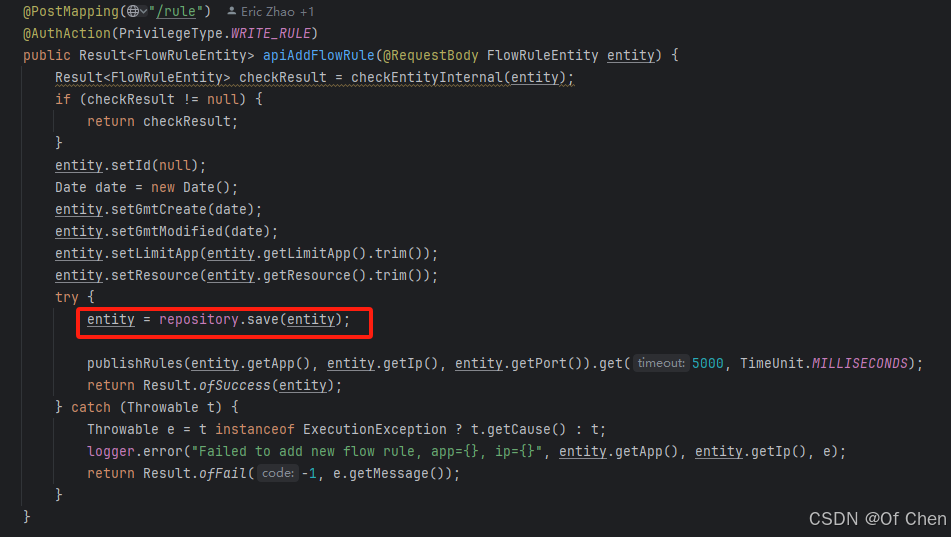
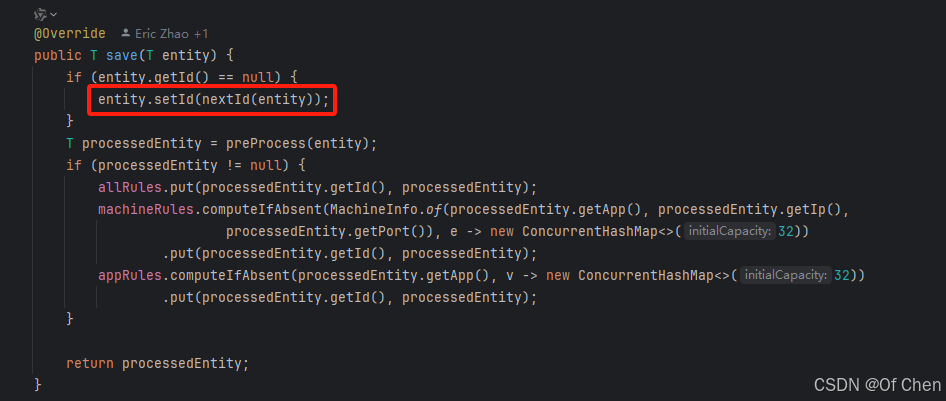

看到了吧,源码里:每次重启sentinel之后再添加规则,规则的id都会1 的开始覆盖,如果原来有id为1得规则,就会被覆盖掉,所以修改规则id就很有必要,不然你刚改造好,跑起来没问题,重启后再新增规则,就会发现原来的不生效了,找都找不到问题在哪里,坑~
改造开始
修改如下图所示几个类即可:

上修改后源码:
InMemoryRuleRepositoryAdapter类
import com.alibaba.csp.sentinel.dashboard.datasource.entity.rule.RuleEntity;
import com.alibaba.csp.sentinel.dashboard.discovery.MachineInfo;
import com.alibaba.csp.sentinel.util.AssertUtil;
import java.util.ArrayList;
import java.util.List;
import java.util.Map;
import java.util.concurrent.ConcurrentHashMap;
/**
* @author leyou
*/
public abstract class InMemoryRuleRepositoryAdapter<T extends RuleEntity> implements RuleRepository<T, Long> {
/**
* {@code <machine, <id, rule>>}
*/
private Map<MachineInfo, Map<Long, T>> machineRules = new ConcurrentHashMap<>(16);
private Map<Long, T> allRules = new ConcurrentHashMap<>(16);
private Map<String, Map<Long, T>> appRules = new ConcurrentHashMap<>(16);
private static final int MAX_RULES_SIZE = 10000;
@Override
public T save(T entity) {
if (entity.getId() == null) {
entity.setId(nextId(entity));
}
T processedEntity = preProcess(entity);
if (processedEntity != null) {
allRules.put(processedEntity.getId(), processedEntity);
machineRules.computeIfAbsent(MachineInfo.of(processedEntity.getApp(), processedEntity.getIp(),
processedEntity.getPort()), e -> new ConcurrentHashMap<>(32))
.put(processedEntity.getId(), processedEntity);
appRules.computeIfAbsent(processedEntity.getApp(), v -> new ConcurrentHashMap<>(32))
.put(processedEntity.getId(), processedEntity);
}
return processedEntity;
}
@Override
public List<T> saveAll(List<T> rules) {
// TODO: check here.
allRules.clear();
machineRules.clear();
appRules.clear();
if (rules == null) {
return null;
}
List<T> savedRules = new ArrayList<>(rules.size());
for (T rule : rules) {
savedRules.add(save(rule));
}
return savedRules;
}
@Override
public T delete(Long id) {
T entity = allRules.remove(id);
if (entity != null) {
if (appRules.get(entity.getApp()) != null) {
appRules.get(entity.getApp()).remove(id);
}
machineRules.get(MachineInfo.of(entity.getApp(), entity.getIp(), entity.getPort())).remove(id);
}
return entity;
}
@Override
public T findById(Long id) {
return allRules.get(id);
}
@Override
public List<T> findAllByMachine(MachineInfo machineInfo) {
Map<Long, T> entities = machineRules.get(machineInfo);
if (entities == null) {
return new ArrayList<>();
}
return new ArrayList<>(entities.values());
}
@Override
public List<T> findAllByApp(String appName) {
AssertUtil.notEmpty(appName, "appName cannot be empty");
Map<Long, T> entities = appRules.get(appName);
if (entities == null) {
return new ArrayList<>();
}
return new ArrayList<>(entities.values());
}
public void clearAll() {
allRules.clear();
machineRules.clear();
appRules.clear();
}
protected T preProcess(T entity) {
return entity;
}
/**
* Get next unused id.
*
* @return next unused id
*/
abstract protected long nextId(T entity);
}
InMemApiDefinitionStore类
import com.alibaba.csp.sentinel.dashboard.datasource.entity.gateway.ApiDefinitionEntity;
import com.alibaba.csp.sentinel.dashboard.repository.rule.InMemoryRuleRepositoryAdapter;
import org.springframework.stereotype.Component;
import org.springframework.util.CollectionUtils;
import java.util.Comparator;
import java.util.concurrent.atomic.AtomicLong;
/**
* Store {@link ApiDefinitionEntity} in memory.
*
* @author cdfive
* @since 1.7.0
*/
@Component
public class InMemApiDefinitionStore extends InMemoryRuleRepositoryAdapter<ApiDefinitionEntity> {
private static AtomicLong ids = new AtomicLong(0);
@Override
protected long nextId(ApiDefinitionEntity entity) {
if (ids.intValue() == 0) {//如果是重启后 且存在已有规则则赋值为最大id+1
if (!CollectionUtils.isEmpty(this.findAllByApp(entity.getApp()))) {
long maxId = this.findAllByApp(entity.getApp()).stream().max(Comparator.comparingLong(ApiDefinitionEntity::getId)).get().getId();
ids.set(maxId);
}
}
return ids.incrementAndGet();
}
}
InMemGatewayFlowRuleStore类
import com.alibaba.csp.sentinel.dashboard.datasource.entity.gateway.GatewayFlowRuleEntity;
import com.alibaba.csp.sentinel.dashboard.repository.rule.InMemoryRuleRepositoryAdapter;
import org.springframework.stereotype.Component;
import org.springframework.util.CollectionUtils;
import java.util.Comparator;
import java.util.concurrent.atomic.AtomicLong;
/**
* Store {@link GatewayFlowRuleEntity} in memory.
*
* @author cdfive
* @since 1.7.0
*/
@Component
public class InMemGatewayFlowRuleStore extends InMemoryRuleRepositoryAdapter<GatewayFlowRuleEntity> {
private static AtomicLong ids = new AtomicLong(0);
@Override
protected long nextId(GatewayFlowRuleEntity entity) {
if (ids.intValue() == 0) { //如果是重启后 且存在已有规则则赋值为最大id+1
if (!CollectionUtils.isEmpty(this.findAllByApp(entity.getApp()))) {
long maxId = this.findAllByApp(entity.getApp()).stream().max(Comparator.comparingLong(GatewayFlowRuleEntity::getId)).get().getId();
ids.set(maxId);
}
}
return ids.incrementAndGet();
}
}
InMemAuthorityRuleStore类
import com.alibaba.csp.sentinel.dashboard.datasource.entity.rule.AuthorityRuleEntity;
import org.springframework.stereotype.Component;
import org.springframework.util.CollectionUtils;
import java.util.Comparator;
import java.util.concurrent.atomic.AtomicLong;
/**
* In-memory storage for authority rules.
*
* @author Eric Zhao
* @since 0.2.1
*/
@Component
public class InMemAuthorityRuleStore extends InMemoryRuleRepositoryAdapter<AuthorityRuleEntity> {
private static AtomicLong ids = new AtomicLong(0);
@Override
protected long nextId(AuthorityRuleEntity entity) {
if (ids.intValue() == 0) {//如果是重启后 且存在已有规则则赋值为最大id+1
if (!CollectionUtils.isEmpty(this.findAllByApp(entity.getApp()))) {
long maxId = this.findAllByApp(entity.getApp()).stream().max(Comparator.comparingLong(AuthorityRuleEntity::getId)).get().getId();
ids.set(maxId);
}
}
return ids.incrementAndGet();
}
}
InMemDegradeRuleStore类
import com.alibaba.csp.sentinel.dashboard.datasource.entity.rule.DegradeRuleEntity;
import org.springframework.stereotype.Component;
import org.springframework.util.CollectionUtils;
import java.util.Comparator;
import java.util.concurrent.atomic.AtomicLong;
/**
* @author leyou
*/
@Component
public class InMemDegradeRuleStore extends InMemoryRuleRepositoryAdapter<DegradeRuleEntity> {
private static AtomicLong ids = new AtomicLong(0);
@Override
protected long nextId(DegradeRuleEntity entity) {
if (ids.intValue() == 0) {//如果是重启后 且存在已有规则则赋值为最大id+1
if (!CollectionUtils.isEmpty(this.findAllByApp(entity.getApp()))) {
long maxId = this.findAllByApp(entity.getApp()).stream().max(Comparator.comparingLong(DegradeRuleEntity::getId)).get().getId();
ids.set(maxId);
}
}
return ids.incrementAndGet();
}
}
InMemFlowRuleStore类
import com.alibaba.csp.sentinel.dashboard.datasource.entity.rule.FlowRuleEntity;
import com.alibaba.csp.sentinel.slots.block.flow.ClusterFlowConfig;
import org.springframework.beans.factory.annotation.Autowired;
import org.springframework.stereotype.Component;
import org.springframework.util.CollectionUtils;
import java.util.Comparator;
import java.util.concurrent.atomic.AtomicLong;
/**
* Store {@link FlowRuleEntity} in memory.
*
* @author leyou
*/
@Component
public class InMemFlowRuleStore extends InMemoryRuleRepositoryAdapter<FlowRuleEntity> {
private static AtomicLong ids = new AtomicLong(0);
@Override
protected long nextId(FlowRuleEntity entity) {
if (ids.intValue() == 0) {//如果是重启后 且存在已有规则则赋值为最大id+1
if (!CollectionUtils.isEmpty(this.findAllByApp(entity.getApp()))) {
long maxId = this.findAllByApp(entity.getApp()).stream().max(Comparator.comparingLong(FlowRuleEntity::getId)).get().getId();
ids.set(maxId);
}
}
return ids.incrementAndGet();
}
@Override
protected FlowRuleEntity preProcess(FlowRuleEntity entity) {
if (entity != null && entity.isClusterMode()) {
ClusterFlowConfig config = entity.getClusterConfig();
if (config == null) {
config = new ClusterFlowConfig();
entity.setClusterConfig(config);
}
// Set cluster rule id.
config.setFlowId(entity.getId());
}
return entity;
}
}
InMemParamFlowRuleStore类
import com.alibaba.csp.sentinel.dashboard.datasource.entity.rule.ParamFlowRuleEntity;
import com.alibaba.csp.sentinel.slots.block.flow.param.ParamFlowClusterConfig;
import org.springframework.stereotype.Component;
import org.springframework.util.CollectionUtils;
import java.util.Comparator;
import java.util.concurrent.atomic.AtomicLong;
/**
* @author Eric Zhao
* @since 0.2.1
*/
@Component
public class InMemParamFlowRuleStore extends InMemoryRuleRepositoryAdapter<ParamFlowRuleEntity> {
private static AtomicLong ids = new AtomicLong(0);
@Override
protected long nextId(ParamFlowRuleEntity entity) {
if (ids.intValue() == 0) {
//如果是重启后 且存在已有规则则赋值为最大id+1
if (!CollectionUtils.isEmpty(this.findAllByApp(entity.getApp()))) {
long maxId = this.findAllByApp(entity.getApp()).stream().max(Comparator.comparingLong(ParamFlowRuleEntity::getId)).get().getId();
ids.set(maxId);
}
}
return ids.incrementAndGet();
}
@Override
protected ParamFlowRuleEntity preProcess(ParamFlowRuleEntity entity) {
if (entity != null && entity.isClusterMode()) {
ParamFlowClusterConfig config = entity.getClusterConfig();
if (config == null) {
config = new ParamFlowClusterConfig();
}
// Set cluster rule id.
config.setFlowId(entity.getId());
}
return entity;
}
}
InMemSystemRuleStore类
import com.alibaba.csp.sentinel.dashboard.datasource.entity.rule.SystemRuleEntity;
import org.springframework.stereotype.Component;
import org.springframework.util.CollectionUtils;
import java.util.Comparator;
import java.util.concurrent.atomic.AtomicLong;
/**
* @author leyou
*/
@Component
public class InMemSystemRuleStore extends InMemoryRuleRepositoryAdapter<SystemRuleEntity> {
private static AtomicLong ids = new AtomicLong(0);
@Override
protected long nextId(SystemRuleEntity entity) {
if (ids.intValue() == 0) {//如果是重启后 且存在已有规则则赋值为最大id+1
if (!CollectionUtils.isEmpty(this.findAllByApp(entity.getApp()))) {
long maxId = this.findAllByApp(entity.getApp()).stream().max(Comparator.comparingLong(SystemRuleEntity::getId)).get().getId();
ids.set(maxId);
}
}
return ids.incrementAndGet();
}
}
好了,到这里改造的内容就大功告成了~
3 项目使用
3.1 引入依赖
项目中需要在pom.xml引入nacos和sentinel相关的依赖
<dependency>
<groupId>com.alibaba.cloud</groupId>
<artifactId>spring-cloud-starter-alibaba-sentinel</artifactId>
<exclusions>
<exclusion>
<artifactId>fastjson</artifactId>
<groupId>com.alibaba</groupId>
</exclusion>
</exclusions>
</dependency>
<!--sentinel集成nacos作为数据源 -->
<dependency>
<groupId>com.alibaba.csp</groupId>
<artifactId>sentinel-datasource-nacos</artifactId>
</dependency>
<!--Sentinel规则持久化至Nacos配置 sentinel流控链路不生效-->
<dependency>
<groupId>com.alibaba.csp</groupId>
<artifactId>sentinel-web-servlet</artifactId>
</dependency>
3.2配置项目中yml或propertie
我这里以yml中的配置为例:
spring:
application:
name: order-service
cloud:
nacos:
server-addr: nacos地址
username: nacos用户名
password: nacos密码
discovery:
namespace: acd06760-3c02-4186-9478-9d28991ddc0b
group: DEMO_DISCOVERY_GROUP
config:
namespace: 1cacd9da-414b-4425-b321-600e6881d941
group: DEMO_CONFIG_GROUP
file-extension: yml
refresh-enabled: true
timeout: 3000
sentinel:
transport:
dashboard: localhost:8080 #控制台地址:指定sentinel控制台服务的地址(与启动sentinel控制台命令配置的地址相同)
eager: true # 启动直接加载配置,关闭懒加载
# 使用nacos来做持久化
datasource:
flow:
nacos:
# 设置Nacos的连接地址、命名空间和Group ID
server-addr: ${spring.cloud.nacos.discovery.server-addr}
username: ${spring.cloud.nacos.discovery.username}
password: ${spring.cloud.nacos.discovery.password}
namespace: ${spring.cloud.nacos.discovery.namespace}
# 设置Nacos中配置文件的命名规则
data-id: ${spring-application-name}-flow-rules # 在修改的sentinel 源码中定义的规则名
group-id: SENTINEL_GROUP
data-type: json
rule-type: flow #枚举类型 严格规范
degrade:
nacos:
server-addr: ${spring.cloud.nacos.discovery.server-addr}
username: ${spring.cloud.nacos.discovery.username}
password: ${spring.cloud.nacos.discovery.password}
group-id: SENTINEL_GROUP
data-id: ${spring-application-name}--degrade-rules
data-type: json
## rule-type设置对应得规则类型,总共七大类型,在com.alibaba.cloud.sentinel.datasource.RuleType这个枚举类中有体现
rule-type: degrade
log:
dir: ./sentinel/logs/${spring.application.name}
filter:
enabled: true
scg:
# 流控触发返回
fallback:
response-body: '{"code":-10000, "data":null, "msg":"前方拥堵,请稍后重试"}'
mode: response
response-status: 500
4 完成
1.启动 Nocos 服务。
2.启动 Sentinel Dashboard。
3.启动项目 xxx-service 服务。
这里在Sentinel-dashboard新建流控规则和熔断规则,就会在nacos对应namespace的SENTINEL_GROUP分组生成xxx-flow-rules和xxx-degrade-rules两个规则,在nacos上修改也会同步到sentinel-dashboard中,好了,这里就实现了流控和熔断两种规则的双向同步了,其他规则如法炮制,这里就不赘述了。

























 1894
1894

 被折叠的 条评论
为什么被折叠?
被折叠的 条评论
为什么被折叠?








